CD162 H.G.CO. - Embossing In Transition
by Gary Kline
Reprinted from "Crown Jewels of the Wire", September 1998, page 13
Part II
In the August 1998 issue of Crown Jewels of the Wire, we looked at the three different CD 162
H.G.CO. embossings that were produced in the late 1880’s to late 1890’s. This month we’ll examine the
last two embossing types, the “PRISM” and “STAMP TYPE”. With these embossing styles, Hemingray
enters a new century and brings to a colorful conclusion the use of the H.G.CO. embossing on their CD
162 signals.
“PRISM” EMBOSSING
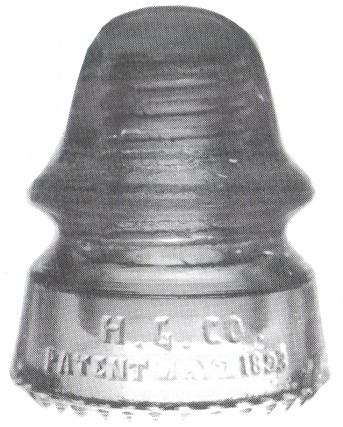
“Prism” Embossing
Around the turn of the century Hemingray began producing insulators with a
new type of embossed letters. Many styles of insulators that Hemingray produced
were affected by this change in embossing. Besides the CD 162 other CD’s that were
made with this type of lettering are CD 106, CD 113, CD 121 CD 134, CD 160, CD
164, CD 201, CD 252, and CD 280.
The embossing is characterized by boldly
engraved letters that are even in height with each other and blocky in form. The
letters are made in such a way that they have a raised prismatic shape, thus the
name “Prism”.
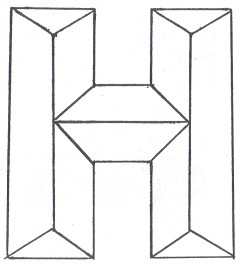
Example of Prism Letter “H” Enhanced
Hemingray must have had a say in deciding what type of lettering would be
engraved in their insulator molds. Why Hemingray broke away from the traditional
type of embossing it had in favor of this blocky style is not fully understood.
It seems unlikely though that they would change the embossing style on so many
insulators without a reason or some tangible benefit.
One possible reason for
such a change taking place could be the change in leadership at the very top of
Hemingray during this time. In December of 1898 Robert Hemingray died leaving
his son, Ralph Gray Hemingray, to become president of Hemingray Glass Co.
As
president, Ralph would make decisions that affected all areas of the company.
His leadership, management style, and vision would be the guide for Hemingray
into the new century. Could the Prism embossed insulators be a reflection of
that vision and style that Ralph had?
Contemporary styling could have also played some part in the decision to
change the embossing. The Prism style of engraving was very typical of lettering
styles that were being using in the late Victorian period. By using a certain
style of lettering a business could invoke a certain feeling or mood about their
company or product. It's possible that Hemingray wanted his embossing to convey
a modern, contemporary feeling about his insulators and company. Certainly the
bold and blocky prism embossing was rather stylish and quite different from the
"plain" embossing of his competitors.
In the CD162's production, there may have been some Prism molds used along
with New Script molds. This would have been towards the end of the New Script's
production. Glass color and quality is the same for the two styles in many
examples. Most likely being produced along with the New Script signals are some
early Prisms in Aqua and also Peacock Blues with a florescent quality. The Prism
style may have also seen production with the Stamp Type embossing that was to
follow. The "Yellow" colored signals are the most likely example of
this.
Although effective for Hemingray at the time, the Prism style was short
lived. Estimated production for the Prism signals is about four years, 1898 to
1902, with some molds being used longer in their supporting roll to other
H.G.CO. embossing styles. I've cataloged eleven different molds in the Prism
style, a number that's comparable to the New Script molds. Like in the previous
embossing styles, the noted lettering differences are in the styling of the twos
and use of periods.
Two new styles of the numeral two make their appearance with the Prism
embossing.

Styles of Numeral "2"
The "looped" based two is found on four molds and the "serif'
based two is employed on seven molds. Out of the seven molds with serif bases,
two lack all periods after the letters H - G - CO. The omitting of all periods
is quite different from the practice seen on previous embossing styles where
only the "CO" was affected.

Looped Base "2"

Serif Base "2"

No Periods after H G CO
Unlike other CD162 H.G.CO's, the Prism style did not see a wide array of
colors being produced. Aqua examples saw the largest production and are quite
common and easy to find. Small amounts of milk, bubbles, and snow occur
regularly in these aqua Prism signals. Finding insulators with more significant
amounts is difficult at best. The most difficult colors to find with the Prism
embossing are the ambers. The "Yellow" signal is the most noted. More
often than not the Prism "Yellow" is seen with damage and is very
scare in mint condition. Drip point counts for the Prism ranged from 30 to 36
with 35 being average.
Following are the known colors in the CD162 H.G.CO. with the Prism style
embossing.
PRISM H.G.CO. COLORS
| AQUA, LIGHT (1) |
BLUE AQUA, LIGHT (1) |
GREEN AQUA, LIGHT (1) |
| AQUA (1) |
BLUE AQUA (2) |
GREEN AQUA (2) |
| AQUA, MILKY (5) |
BLUE, HEMINGRAY (3) |
YELLOW (7) |
| BLUE, PEACOCK (4) |
AMBER, GOLDEN ORANGE (6) |
|
"STAMP TYPE" EMBOSSING
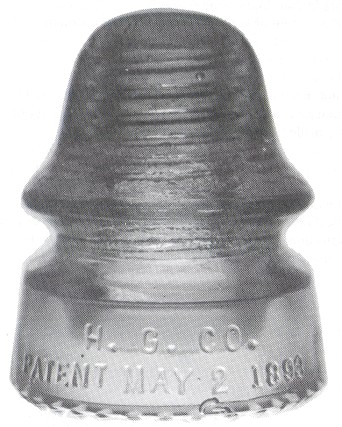
"Stamp Type" Embossing
One more change was in store for the CD 162 H.G.CO.'s embossing before being
retired. The change came in the form of a style of embossing that appears as
though the letters were produced by a typewriter. Actually a hand held punch was
used to stamp the individual letters into the mold. The result of this is that
the letter placements are uneven and can jump around quite a bit. Because of the
combined features of type letters on a stamp punch, collectors refer to this
embossing style as "Stamp Type".
Unlike the Prism embossing this embossing change seems to be more of a
practical nature than style. One thing about the Stamp Type is that it could be
applied rather quickly to the mold with uniform results. The crisp uniform
letters also made the embossing easily readable. With the Stamp Type, Hemingray
seemed to finally find a type of lettering that they could live with. In the
decades to follow, all Hemingray signals would use the same Stamp Type style of
lettering in their embossing.
Production of the Stamp Type H.G.CO. signals took place during much of the
first decade of this century. Estimated production was 1902 to 1909. Demand for
the H.G.CO signals was at its peak and more molds were produced than any other
time. The final count is not in yet on the total number of Stamp Type molds. The
number though is already greater than the combined total of all previously made
CD162 molds.
There is one mold variant and one mold oddity to report. The mold oddity has
a series of eight bumps located on the dome. Fortune tellers and readers of
bumps maybe able to tell us what was going on with this mold. These bumpy
signals have been seen in Aqua, Red Amber, and Orange Amber. The mold variant
also involves the dome area. Instead of the normal dome we think of, this
signal's dome is slightly narrower and cone shaped. Crowning the top of this
dome is a flat, button top. The Flat Top signal has been seen in Electric Blue
and Aqua.
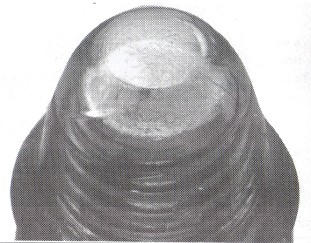
Close up of flat top's dome detail
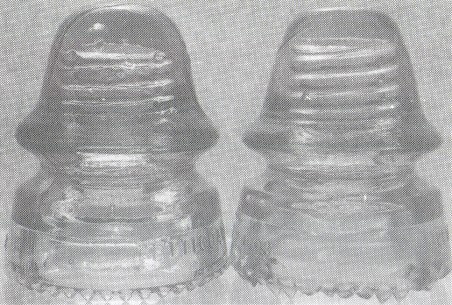
Left: Bumpy dome signal. Right: Flat top dome.
Because the Stamp Type molds were no longer hand engraved, the variety in the
styling of the numeral two disappeared. One theme that was carried over from the
Prism style was the lack of periods used in H. G. CO. Three different molds are
known to have been made that omitted all the periods after H. G. CO.
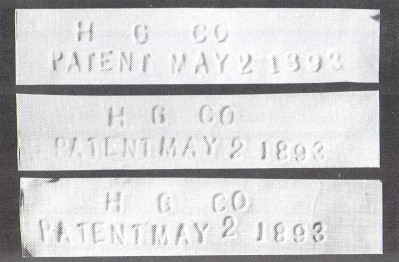
Periods after H. G. co. omitted on three molds.
One would think that by using a punch to make the letters that errors would
be nonexistent. The fact is though that the Stamp Type embossing has more errors
occurring in it than all of the other embossing styles. The errors center around
usage of the improper letter punches and the placement of the type on the mold.
For some reason the engraver had trouble with the word PETTICOAT and used the
wrong letter punches. Realizing his mistake though, he restamped the correct
letters over the wrong ones. One version of misspelled PETTICOAT has the
engraver stamping out the letters PETTICAT then correcting it by stamping
"OA" over "AT".

"PETTICAT" variety -- "OA" stamped over
"AT".
Three examples of a "PETTICOAY" embossing are known. One is the
uncorrected PETTICOAY spelling. Another PETTICOAY example has the letter
"T" stamped over "Y". In the final example the spelling
actually started out as "PATTICOAY" and was corrected by restamping
the letters "E" and "T" in their proper places.

"PETTICOAY" variety -- "T" stamped over
"Y".
One PETTICOAT oddity that should be mentioned is the CD 162 that was made
with PETTICOAT stamped on both halves of the mold. At the moment, it is unclear
whether this mold can be attributed to the H.G.CO. embossed signals or whether
it came later with the HEMINGRAY / PATENT DATE embossing. Also not known is
whether the mold was an error or if it was intentionally made that way for some
reason.
A favorite error mold of mine involves a patent date that was stamped with
the numbers very close together. A period had to be employed after the number
"2" in order to keep the date from appearing futuristic. This same
error shows up on a CD133 H.G.CO. too.

A period after the "2" helps keep order in this error mold.
In another mold the period shows up again with the patent date, but this time
it's at the very end of the date. It's like the engraver stamped out PATENT MAY
2 1893 - PERIOD! as if to say "There! I finally got it right!"

In this error mold a period is
placed at the end of the patent date.
When compared to the other styles, the Stamp Type lettering may seem a little
plain. But that's not where these signals shine. They more than make up for
their plain embossing by being the most colorful and plentiful H.G.CO. embossed
signals that Hemingray produced.
This fact was well represented in the survey. Pieces reported numbered well
over 300 with collectors coming up with over 90 different names for colors!
Wading through all these colors has been mind boggling. There seems to be an
endless variety in amber colors that were produced. Improperly mixed glass
batches of light and dark material caused most of the odd amber color variants
we see today. Every signal collector I know has grappled at the task of finding
the proper adjective for their signals color. Most of these come in the form of
combining the two most pronounced colors of the signal like; Yellow Whiskey,
Golden Olive, or Red Brown. Sometimes a signal's color will defy description
leaving the namer exhausted like; "Reddish Orange with a Mustard-Olivey
kind of thing going on."
In making the Stamp Type color chart an attempt was made to stay within a
color's recognized boundary. Due to the many color and tint variants in Blue and
Amber, it's recognized that all the colors out there may not neatly fit in with
those listed.
There are a few things to note in the Stamp Type Colors. Not since the
Transition SB has a purple signal been seen. In the Stamp Type, Purple is back
with a large enough production to put a smile on most collectors faces. Colors
of purple range from a Light Lilac to a Royal Purple that was described as
"Black". As mentioned before, the "Yellow" Stamp Type signal
may have been produced along with the Prism's "Yellow" signal. The
"Yellow" signal like the Prism is scarce and most often found with
damage. Of all the impurities found in these signals, Milk plays the biggest
roll. Most colors have been seen with small wisps in them. Larger amounts of
milk occur in the colors Peacock, Electric Blue, and Aqua. Amber swirling
commonly occurs in Amber signals but is not seen to any degree in other colors.
Drip point counts for the Stamp Type ranged from 30 to 40 with 37 being the
average. Interestingly, all Royal Purples reported had drip counts of 40.
Because of the Stamp Types high production and survival rate most colors can
be readily found today. The exception to this is the Burgundy, Green, Clear and
Tint colored signals.
STAMP TYPE H.G.CO. COLORS
| CLEAR (10) |
AQUA(1) |
BLUE, ELECTRIC, DK (3) |
| SMOKE TINT(9) |
AQUA, BLUE (1) |
BLUE, ELECTRIC, MILKY (4) |
| PINK TINT (9) |
AQUA, GREEN (1) |
BLUE, PEACOCK, LT. (2) |
| GREEN (8) |
AQUA,LT.GREEN(1) |
BLUE, PEACOCK (2) |
| GREEN, JADE (6) |
AQUA, JADE (5) |
BLUE, PEACOCK, DK (3) |
| LILAC (4) |
AQUA, MILKY (5) |
BLUE, PEACOCK, MILKY (6) |
| PURPLE, LT. (4) |
AQUA,VASELINE(5) |
BLUE, INK PEACOCK (5) |
| PURPLE (3) |
BLUE, JADE (7) |
AMBER, RED (3) |
| PURPLE, DK (4) |
BLUE, HEMINGRAY(3) |
AMBER, OXBLOOD (5) |
| PURPLE, ROYAL (4) |
BLUE, LT. POWDER (6) |
AMBER, ROOTBEER (2) |
| VIOLET, LT. (8) |
BLUE, ELECTRIC, LT.(2) |
AMBER, BLACKGLASS (7) |
| BURGUNDY (9) |
BLUE, ELECTRIC (2) |
AMBER, HONEY (3) |
| YELLOW (6) |
AMBER, GOLDEN (3) |
AMBER, WHISKEY (2) |
| AMBER, OLIVE (3) |
AMBER, MUSTARD (5) |
AMBER, ORANGE, LT.(3) |
| AMBER, BROWN (2) |
|
AMBER, ORANGE (2) |
| AMBER, BROWN DK (3) |
|
AMBER, ORANGE, DK. (2) |
| AMBER, RED ORANGE (3) |
|
AMBER, TWO TONE (2) |
| AMBER, BUTTERSCOTCH (4) |
|
|
I would like to thank each and every collectors who filled out surveys and
supplied me with examples of signals to examine. Each one of you contributed an
important piece to the puzzle. I appreciate your patience and support. To each
of you this article is dedicated. Special thanks to Charlie Allmon, Bill Meier,
Al Way, Ray Klingensmith, Bob Stahr and Paul Ickes. Without your encouragement,
enthusiasm and ideas, this article could not have been written.
|
